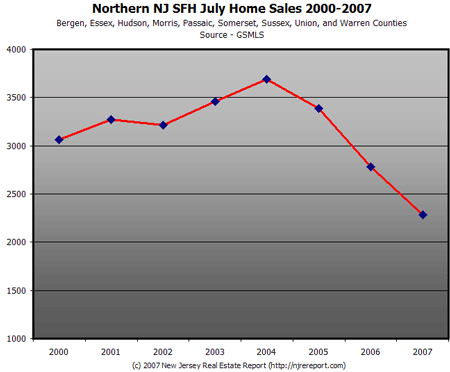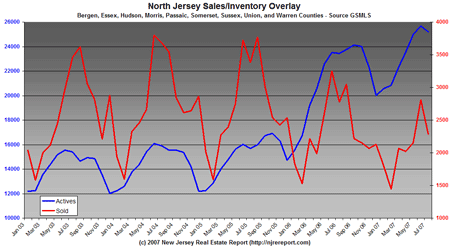Turmoil in the U.S. home-mortgage market is starting to pinch even buyers of high-end homes with good credit records, in the latest sign of rising anxiety among lenders and investors.
This surge in rates on so-called jumbo loans is particularly notable because rates on 10-year Treasury bonds have been falling. Normally, mortgage rates move in tandem with Treasurys, but market jitters have caused investors to ditch mortgage securities.
Meanwhile, American Home Mortgage Investment Corp. finally succumbed yesterday to the mortgage-sector chaos that had crippled it in recent weeks and filed for protection from creditors under Chapter 11 of U.S. bankruptcy law. And executives at Fannie Mae, the government-sponsored entity that along with Freddie Mac provides funding for home loans, asked the companies’ government overseer to raise the maximum amount of home mortgages and related securities Fannie can hold in its investment portfolio. The goal would be to boost demand for mortgages in general, proponents of the idea said.
…
Lenders — having already slashed lending to subprime borrowers, as those with weak credit records are known — now are jacking up rates on jumbo mortgages for prime borrowers. These mortgages exceed the $417,000 limit for loans eligible for purchase and guarantee by Fannie and Freddie. They account for about 16% of the total mortgage market, according to Inside Mortgage Finance, a trade publication, and are especially prevalent in California, New Jersey, New York City, Washington, D.C., and other locales with high home costs.
Lenders were charging an average 7.34% for prime 30-year fixed-rate jumbo loans yesterday, according to a survey by financial publisher HSH Associates. That is up from an average of about 7.1% last week and 6.5% in mid-May.
The higher costs for such loans will put further downward pressure on home prices in areas where homes typically bought by middle-class people can easily cost $500,000 to $700,000.
…
The jump in jumbo-mortgage rates is the latest gust in a subprime storm that has sunk two hedge funds run by Bear Stearns Cos., knocked American Home and dozens of other lenders out of business, battered an already weak housing market and fueled weeks of stock-market turmoil. Yesterday, the Dow Jones Industrial Average rebounded 286.87 points, or 2.2%, to 13468.78.
Alarmed by weakness in the housing market and rising foreclosures, investors who buy loans and securities backed by mortgages have fled the market for almost any loan that isn’t guaranteed by Fannie Mae or Freddie Mac, Mr. Duncan and others said. That means lenders must either hold loans, at least temporarily, and face the risk of falling values for them, or seek out borrowers who qualify for loans that can be purchased by Fannie and Freddie.
For other types of loans, Mr. Duncan said, “there is no market.” He said it isn’t clear how long the market will remain disrupted, but said some mortgage bankers fear the current paralysis could last weeks. “We’re getting calls from members [of the lenders’ association] who are quite desperate about their circumstances,” Mr. Duncan said. Large banks have the capacity to retain loans on their books, but many other lenders can only make loans that can be sold quickly.
…
The market disruption came as crushing news for Gary Cecere, a mechanic who lives in Croton-on-Hudson, N.Y. Mr. Cecere said he learned yesterday that Wells Fargo & Co. was no longer willing to complete a planned package of two mortgage loans that would allow him to buy a $410,000 four-bedroom home in Mahopac, N.Y. Hugo Iodice, a branch manager at Manhattan Mortgage Co. who is acting as a loan broker for Mr. Cecere, blamed tighter standards imposed by Wells Fargo on Alt-A loans. A Wells Fargo spokesman had no immediate comment.
“I was getting ready to close [on the home purchase] this week, and they basically pulled the carpet out from under my feet,” said Mr. Cecere. For now, he said, his wife, five children, two cats and a dog are cramped into a two-bedroom temporary apartment, awaiting a move. Mr. Iodice said he is trying to find an alternative loan for the family.
Even borrowers with good credit records who can afford a large down payment are finding rates surprisingly steep if they can’t qualify for a loan that can be sold to Fannie or Freddie. Rates on prime jumbo loans have risen so fast that “nobody in their right mind would pull the trigger” and accept one now, unless they couldn’t delay a home purchase, said Darren Weisberg, president of PFG Mortgage Services Inc., a mortgage broker in Lake Forest, Ill.
Some lenders are pulling the plug on whole categories of loans. Yesterday, National City Corp., a Cleveland banking company, said it has suspended its offerings of home-equity loans or lines of credit made through brokers rather than the bank’s branches. The company cited market conditions.





